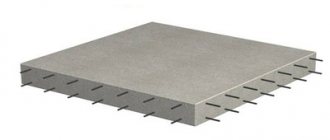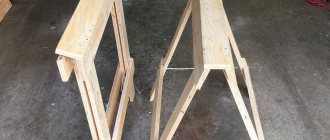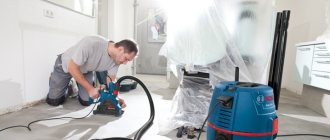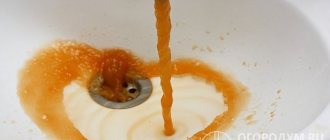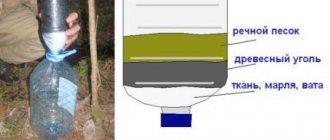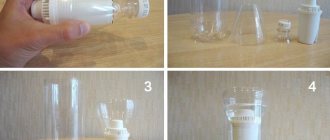Probably every housewife will agree that the house cannot do without such an important thing as a vacuum cleaner. Among the great variety of models, experts advise choosing ones with an aquafilter in order to get better cleaning results. With such models, dust absorption occurs more efficiently. They have recently become increasingly popular. If your model does not have a device that contains water, which allows for better cleaning, then do not be upset.
How does a water filter work?
Even if you recently purchased a vacuum cleaner without a water filter or you have a slightly outdated model at your disposal, don’t worry, below we’ll look at how you can make a water filter for your vacuum cleaner model with your own hands.
The principle of operation of a homemade vacuum cleaner with an aqua filter
Under natural conditions, even the smallest particles of dust are bound by water - rain, snow, dew, fog. The same principle is used in vacuum cleaners with an aquafilter: the water vortex created inside the aquafilter collects even fine dust, which no solid filter element is capable of catching.
Modern models of vacuum cleaners with a water filter not only retain up to 99.9% of sucked dust and dirt, but also purify the air and work as humidifiers.
Such devices are very convenient and economical to use - there is no need to regularly buy expensive bags and other consumables, since all the dust settles in a water tank.
To clean it, just drain the dirty water and rinse the container. The only significant drawback of vacuum cleaners of this type is the high price.
If the appearance of the device is not important, you can assemble a homemade water vacuum cleaner, which in terms of performance and efficiency will not be inferior to expensive models from well-known brands.
Such a vacuum cleaner will become an indispensable assistant not only when cleaning an apartment, but also when performing dusty construction and finishing work - scraping walls, sanding, etc.
An aquafilter is an additional working element, or rather a container of water through which the air sucked in by the vacuum cleaner passes due to vacuum.
The water filter is installed before the vacuum cleaner, as a result, all dirt and dust remain in the water, and already purified air enters the vacuum cleaner itself.
What you need to make a water filter for a vacuum cleaner with your own hands
To make a water filter for a vacuum cleaner with your own hands, you will need the following materials and tools:
- Any container with an airtight lid. This could be a 19-liter plastic cooler bottle or a large plastic bucket with a tight-fitting lid;
- Coarse foam rubber, mesh or any other reusable filter material to prevent water from entering the vacuum cleaner engine;
- Additional corrugated hose for a vacuum cleaner (will connect the vacuum cleaner and the water filter);
- Construction sealant;
- Sewer pipe with a diameter of 50 mm;
- Drill and drill bit with a diameter of 6 mm;
- Measuring tools - ruler, tape measure, pencil.
As for the pipes, their configuration and quantity are determined based on the shape and size of the container of the homemade aqua filter.
So, to make a water filter from a 12-liter plastic bucket you will need the following items of PVC pipes:
- sewer pipe d 50 mm L 250 mm polypropylene - 3 pcs.;
- tee d 50 mm L 153 mm 90 degrees - 2 pcs.;
- plugs d 50 mm - 2 pcs.
Manufacturing process - step-by-step instructions
The process of making an aqua filter itself consists of several stages:
- In the upper part of the bucket (it is enough to step back about 10 centimeters from the upper border), you need to make two holes with a diameter of 50 mm opposite each other - this will be the entrance and exit of a homemade aqua filter;
- Several holes should be drilled in the bottom of one of the tees. This should be done evenly over the entire surface. The total area of the holes should be approximately equal to the diameter of the pipe used. We put plugs on the pipe from two side ends:
- We make a hole with a diameter of 40-50 mm in one of the pipes;
- Next, we assemble the pipes into a single structure in accordance with the figure:
- Pour water into the container so that the lower part of the tee with the holes is completely covered with water;
- Close the water filter cover and connect the vacuum cleaner:
- We test the aquafilter.
VIDEO INSTRUCTIONS It is recommended to carry out the first tests at low speed, monitoring the condition of the corrugated hose running from the aqua filter to the vacuum cleaner (it must be dry).
If traces of water are visible in the corrugated hose, it is necessary to close the air intake hole inside the filter with coarse foam rubber or other porous filter material.
Making an aqua filter from a pan and a plastic bottle, detailed instructions
You will need a pan, for example, made of aluminum, and a bottle with a capacity of five to six liters so that it fits in the pan. You will also need a hose and several screws.
Proceed according to the following scheme:
- it is recommended to remove the bottom of the pan to reduce the weight of the device;
- using self-tapping screws, the pan is attached by the handle to the vacuum cleaner at the air outlet;
- Holes are shot in a plastic container, a liter of water is poured, after which the bottle is placed in the pan;
- the first end of the tube is fixed to the vacuum cleaner, the second is lowered into the eggplant.
Water is poured into the pan, all the tubes are connected, and the lid is sealed. When the use of the vacuum cleaner is completed, the lid is removed, the dirty water is poured out, the container is cleaned and dried.
Even more useful tips are in the video:
What is a water filter for?
With the help of a water filter built into the vacuum cleaner, you will be able to effectively wet clean the room, get rid of bacteria, pathogens, dust mites, animal hair, fill the air with cleanliness, freshness and humidify it.
The principle of operation of the aquafilter of a vacuum cleaner
By and large, an aquafilter is a device that has a reservoir filled with water. The separator in the device, which operates as a cyclone, moves a container of water. The vacuum cleaner sucks in air with particles of dust, litter and dirt, then it all passes through water, in which all the contaminants settle. After this, the air passes through filters, where it is finally cleaned and humidified. As a result, clean and fresh air returns to the room.
After each use of a vacuum cleaner with an aqua filter, you need to wash the container and thoroughly dry all existing filters to prevent the growth of bacteria.
Types of aquafilters
There are two types of water filters:
- Separate.
The work of this type of aqua filter is to separate air from dust particles due to centrifugal force. Contaminated particles that enter the filter remain in the water without entering the air of the living room. The main advantage of vacuum cleaners of this type is the higher quality of cleaning compared to others, and they are also durable. However, separate models are not cheap.
Separate filter
- Hookah bars.
Vacuum cleaners of this type have a fairly simple design. These devices cope better with coarse dust, but they have a hard time with fine dust. However, this drawback can easily be corrected by installing additional filters. One of the inconveniences of using a hookah filter is the need for frequent, systematic washing and high-quality drying. In addition, it is equipped with a fairly small liquid reservoir.
Aquafilter in a vacuum cleaner
Membrane filter
The first type of filters is made of very dense fabric. It's quite easy to do.
Important! know the size of the bag suitable for your model, buy a material of suitable density at a hardware store and sew the bag according to the model of the original dust collector developed by the manufacturer.
To increase the density, the membrane fabric can be folded in two or more layers. The base for attaching the dust collector can be cut out of thick cardboard or plastic. There are several ways to attach the bag to the base.
In the first one we need glue. With its help, we simply fix the neck of the bag between two pieces of cardboard.
In the second case, we will take ordinary Velcro. The first half of the Velcro should be glued to a plastic or cardboard base, and the second half should be sewn to the neck of the bag. Your dust collector is ready for use.
Read more: what and how to make a vacuum cleaner bag.
Garden device
For owners of private households with their own yard, the issue of removing leaves and other debris becomes relevant. Garden vacuum cleaners are collected for these purposes.
It is difficult to install a shredder with your own hands. But you can get by by increasing the diameter of the suction tube. The best donor in this case will be an old domestically produced device. A plastic container is installed in a device of this type with a prepared hole of suitable diameter. All that remains is to connect a wider corrugation to the container with a dense piece of pipe at the other end. A sewer pipe is perfect.
Whatever a homemade construction vacuum cleaner for the home is, it cannot compare with an industrial one, but if necessary, it can become an indispensable assistant for one-time use.
Originally posted 2018-03-28 15:19:32.
Advantages and disadvantages
Before you make a filter for a vacuum cleaner with your own hands, you need to familiarize yourself with the advantages and disadvantages of a homemade container. What are the features of homemade products? The main advantage of making filters for a vacuum cleaner with your own hands is saving money that would have to be spent on purchasing factory cleaning elements. In some cases, manufacturing costs can be completely eliminated, since all the necessary elements can be selected in the household. Also, the advantages of homemade filters include the fact that thanks to them you can significantly expand the functionality of your home vacuum cleaner.
Despite the many advantages, homemade cleaning elements also have certain disadvantages. These include the fact that not all models of vacuum cleaners can install such filters. It is not recommended to use foreign parts in equipment that is under warranty because if it breaks, warranty service will be denied. After weighing all the pros and cons, you can get to work.
Two options for assembling a cyclone
Most woodworking and cutting power tools are equipped with a connection to a vacuum cleaner. This convenient function eliminates the accumulation of dust in the apartment, but when performing large volumes of work, you have to frequently clean the filter. A homemade high-capacity cyclone, which can be assembled in two versions, will help increase productivity.
Cyclone from PET barrels
A homemade cyclone with a large capacity is ideal for a home woodworking workshop. A PET barrel with a lid was used in the manufacture of the filter housing. The capacity depends on the power of the vacuum cleaner. For a low-power unit, it is undesirable to take a barrel with a capacity of more than 5 liters.
Step-by-step manufacturing of a cyclone includes the following steps:
A holder for a car filter is attached to the inside of the steel strip barrel lid. The design resembles a pyramid of three petals connected at the top by a pin. A hole is cut in the center of the lid to connect the vacuum cleaner hose.
The car filter is placed on the holder. Place a wide washer on the protruding pin in the center and tighten the nut firmly. The filter must be pressed tightly against the lid, otherwise dust from the barrel will penetrate through the pipe into the vacuum cleaner.
A piece of plastic pipe is fixed in the hole in the lid. Through the outlet pipe, clean air will be drawn in by the vacuum cleaner. There is a factory filter inside the unit. Do not pull it out to increase suction power. The membrane filter will additionally protect the fan from dust.
A car filter needs additional protection. A nylon women's stocking is pulled over it to protect against small dust particles. Additionally, the filter is protected with a galvanized casing. The bumper will prevent large solid particles from damaging the filter element.
To suck up debris, an inlet pipe made from a piece of PET pipe is cut into the side wall of the upper part of the barrel. Inside the container, the element is secured with a clamp. The tube is positioned with an inclination towards the bottom and touching the side surface of the barrel.
The disadvantage of PET barrels is their thin soft walls. While the vacuum cleaner is operating, a vacuum is formed inside the container. To prevent the walls from “playing,” the barrel is reinforced with a steel strip.
A cyclone made from a barrel together with a vacuum cleaner represents an overall design. For ease of use, the frame is made of plywood. Four wheels are attached to the bottom.
A filter with a vacuum cleaner is installed on top of the frame. All elements are securely fixed, but allow for easy dismantling.
The hose from the vacuum cleaner is fixed to the pipe on the filter cover. A corrugated hose is placed on the suction pipe of the cyclone. Check the sealing of the joints, otherwise if there are even the slightest cracks, productivity will decrease.
The cyclone test can be carried out on sawdust. After turning on the vacuum cleaner, intense suction will begin. The sawdust will hit the walls of the barrel and settle at the bottom.
Small cyclone made from a traffic cone
A cyclone made from a PET barrel is classified as a semi-industrial unit in terms of performance. But what if you need a compact filter for a small amount of work? A neat design can be made from a traffic cone.
Assembling the cyclone consists of the following steps:
For a dust collector, you will similarly need a PET barrel, but you can take one with a small capacity of 3–5 liters.
Using a hacksaw or grinder, cut a square stand from the cone. The blank is placed on a sheet of plywood and the inner hole is outlined with a pencil. This will be the cap on the cone.
A hole is cut in the center of the plywood cover, where a piece of plastic pipe is hermetically mounted. The outlet pipe is buried exactly to the middle of the cone. A short pipe will prevent turbulence from forming. Debris will be drawn in through the long pipe.
An inlet pipe is cut into the side wall of the cone. Another circle is cut out of plywood, with a diameter slightly smaller than the barrel lid. A hole is drilled in the center into which the sharp part of the cone is inserted. Another hole is cut in the center of the barrel lid. The top is sawed off from the cone. A plywood circle placed on the tip of the filter formed a kind of flange connection. The cone is inserted into the hole on the lid of the barrel.
All elements of the cyclone are assembled and the connection tightness is checked. The filter with a vacuum cleaner is mounted on a plywood frame. Hoses are connected to the inlet and outlet pipes.
Upon completion of assembly, a test is carried out. If there is no air leakage at the joints, debris will be drawn into the PET barrel.
If the farm does not have a traffic cone, the blank can be easily made from galvanized sheet. It is better to solder the joints for tightness.
In the absence of a cone, it is easier to use a 150 mm thick PET sewer pipe. The lower part of the cone will be replaced by a plastic bottle. The bottom of the container is cut off and thrown away. The upper part of the bottle with the neck is placed on the lower part of the filter. The inlet and outlet pipes are connected from above using shaped elements.
A homemade cyclone operates on the principle of centrifugal force. A spacious container will allow you to collect a large amount of debris during repair work.
Types of filters
Currently they come in the following varieties:
- Membrane. This filter is used more often than others in modern models and is considered the cheapest way to remove dust. A membrane is a semi-permeable medium that freely allows oxygen and water to pass through.
- Water. This filter allows air and dirt to pass through a container of water.
- Cyclonic. It is considered inexpensive, but the quality is not inferior to membrane or water filters. In this case, air with dust is passed through a special housing having a cylindrical shape.
Water filter
The popularity of the aquafilter is not only because it makes cleaning more efficient, but also because it humidifies the air. All sucked debris passes through a container of water.
This filter is capable of retaining even fine dust and pollen. This feature of the vacuum cleaner is appreciated by people who are allergic to dust.
Attention! Due to the water compartment located in the body, the vacuum cleaner becomes heavy.
When choosing this type of home assistant, try to see if it will be easy for you to move around the house with it.
You can make this type of filter yourself. What can be made from:
- Separator . With its help, waste will be divided into large and small;
- Water container with a sealed lid;
- Small fan When choosing, be guided by its noise level;
- water pump.
We take a breaker, a casing and a storage unit to install all these parts on the dust collector of the vacuum cleaner.
Zinc coated fasteners will serve as fastening.
Don't forget to put polyethylene on the bottom of the filter. It will perform soundproofing functions.
The last thing we install is the pump. You can secure it using a rubber ring.
Important! Monitor the water level while using the filter.
How to choose material for manufacturing
Motor for an electric pump The simplest model is assembled from a 2 liter bottle or a 5–10 liter container.
A hose is installed on the neck to suck up debris. A filter is mounted inside the housing. A motor from a children's toy or tape recorder is attached to the bottom of the device. The fan blades are cut out of tin, the edges are cleaned, and the impeller is mounted on the shaft from the motor. This vacuum cleaner can operate both from mains power and batteries. However, the power of the model is low and is only suitable for small ponds.
If there is no ready-made filter, it is replaced with a homemade design. For example, they sew a garbage bag from water-permeable fabric, like tulle and organza, and insert it into the receiving pipe. Then install a filter from a plumbing adapter and sponges. The edge of the adapter is sawed off at an angle and sanded, then sponges are glued to the edges. A gap is left between them for water to enter. It is better to protect foam rubber with a piece of linoleum. This design does not allow large debris, insects, leaves to pass through, and small debris is retained in the bag itself.
Vacuum cleaner from a submersible pump
Vacuum cleaner from a submersible pump for a large pool This option is much more convenient to use when cleaning the bottom of a complex configuration. A submersible pump is used for it, capable of operating under water. The step-by-step instructions are simple.
- A tee is assembled from a polypropylene pipe. The pipes are connected by soldering.
- Plugs are put on the ends of the segments.
- A longitudinal hole is cut out from the bottom of the pipe and the edges are cleaned. A handle is welded to the top of the tee.
- In the center of the plunger, extend the through hole and insert a tube into it. Connect the plunger to the corrugated pipe.
- The structure is connected to the inlet valve on the pump.
The debris in such a vacuum cleaner remains on the filter, so the latter needs to be cleaned more often.
Water tank cleaning process
Before cleaning, you need to check the operation of the vacuum cleaner , and if everything functions correctly, then start working.
First, all debris is removed from the surface of the water with a net, then the walls of the pool, which are located above the water, are cleaned with vacuum cleaners.
This can be done with a simple brush. After this, you need to walk along the wall where the water line is located . There is often more dirt there than below. After this, you need to go lower and reach the bottom of the pool.
Depending on the size of the pool, it may take an hour or two to completely clean the pool. After completing work in any of the vacuum cleaners, you need to remove the filter (cotton wool, padding polyester), clean it and dry it.
It is important to remember that you can turn on the vacuum cleaner when the pool is empty . Make sure that no water gets on the electronics, otherwise a short circuit may occur.
To clean the pool less often, you need to keep it clean with special chemicals¸ and cover it with a lid when not in use.
You will find a lot of important and useful information about pool vacuum cleaners in this section.
How to make a detergent?
Using the instructions, you can make a washing device from a simple vacuum cleaner. Usually people use a washing machine very rarely. This device is intended for general cleaning of the house or when you need to wash away dirty spots.
The step-by-step instructions for creating the device are as follows.
- Where there is air flow, you need to fix the water filter. The following materials are needed for the filter: a container, an angle, a short pipe for sewage, a corrugation with a diameter suitable for the pipe. A hose from an old vacuum cleaner is suitable as a corrugation. Since the hose is very soft, it will roll up well.
- It is necessary to measure the diameter of the place where you need to insert the nozzle and extension tubes, and purchase an angle that can fit this diameter. Then you need to saw off the tube so that it cannot reach the bottom.
- Using a knife, you need to cut round holes on the lid. The diameter of the holes must be even and suitable for the tube.
- Then tubes should be inserted around the perimeter and reinforced with a glue gun.
- After this, you need to make a fabric filter for a short tube. Such a filter will prevent water drops from entering the vacuum cleaner, since the fabric is a reliable material. Using Chinese electrical tape, you need to wrap this fabric around plastic and pull it tightly.
- Next, take the hose from the vacuum cleaner and insert it into the short tube, and then attach the nozzle to it. Using electrical tape, these connections must be sealed.
- Then you need to tightly close the lid of the bucket and clean the house. As a result of cleaning, all the water will be located in the tank. And the filter will remain dry, there will only be dirt from cleaning on it. The pipe that was inserted into the vacuum cleaner will also be dry.
Making a filter for a Samsung vacuum cleaner with your own hands
Many people prefer vacuum cleaners. Therefore, the question of how to make a filter for a vacuum cleaner of this brand with your own hands is very relevant. First you need to remove the installed filter from it. After this, you need to purchase a cabin filter for the Lada Kalina and a sealant gasket at any auto parts store. You need to cut out the accordion from the purchased cleaning element and trim the insides. The sealant should be applied to the accordion around the entire perimeter. After this, install the filter element into the shell and leave to dry for several hours. After this, the filter for the Samsung vacuum cleaner (with your own hands) is ready for use.
But these are not all the options. You can make a filter for a Karcher vacuum cleaner with your own hands in an identical way. Only for this you will need an air element from the Moskvich-2141 car.
Selecting consumables
Oddly enough, ordinary sand is not suitable for a sandblasting machine, because its particles are different from each other, and this can negatively affect the final result.
Too large particles in regular sand can cause serious scratches. The solution to this issue is an abrasive mixture, which can be found in almost any specialized store. They may differ in particle shape and size. All this affects the intensity and quality of processing, but it is worth considering that not every mixture is suitable for very soft surfaces.
Hand-cleaned coastal sand can also be used as a mixture.
Currently, it is recommended to move away from previous traditions, because the market offers other, more effective mixtures, and besides, sand is quite dangerous for the human lungs.
In some countries of the European zone, the use of this material is even legally prohibited due to the fact that it can cause harm to humans.
Separator filter
This filter will require a separator, a pump, a water tank, and a fan. All elements must match each other in size and height.
This modification requires a person to have certain skills and technical training.
It is difficult to assemble such a filter yourself, so the simpler and more affordable assembly options mentioned above are often chosen.
So, water filters for vacuum cleaners have many undeniable advantages. In order not to purchase an expensive model, it is quite easy and quick to assemble a homemade aqua filter model.
Every housewife or owner in the house has an unnecessary pan or bucket, and there are also several pieces of pipes or hoses. With a little time and little effort, you can create a water filter from these scrap materials.
Noticed a mistake? Select it and press Ctrl+Enter to let us know.

